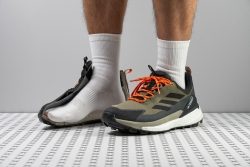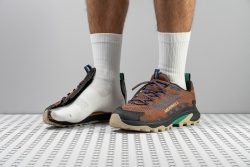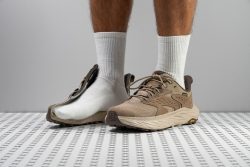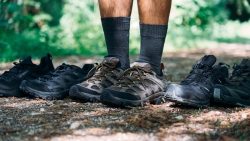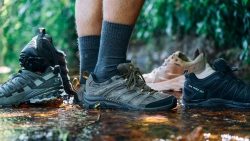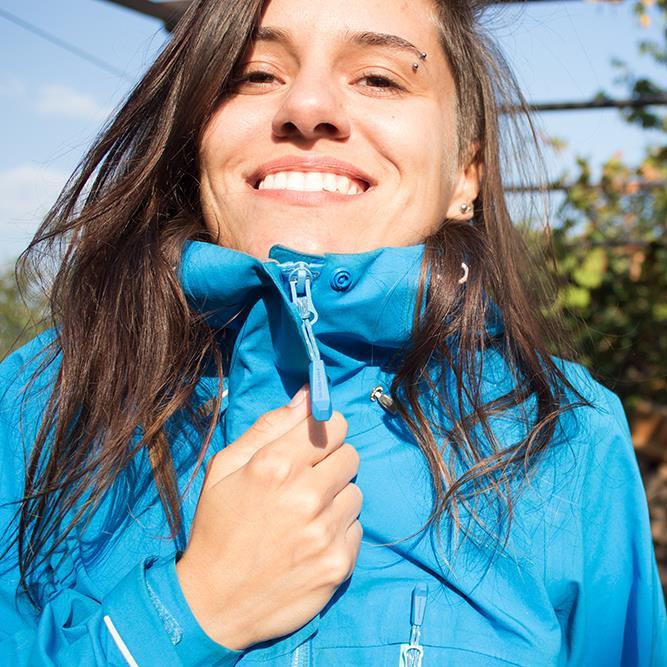4 Hiking Shoes With The Best Shock Absorption in 2025
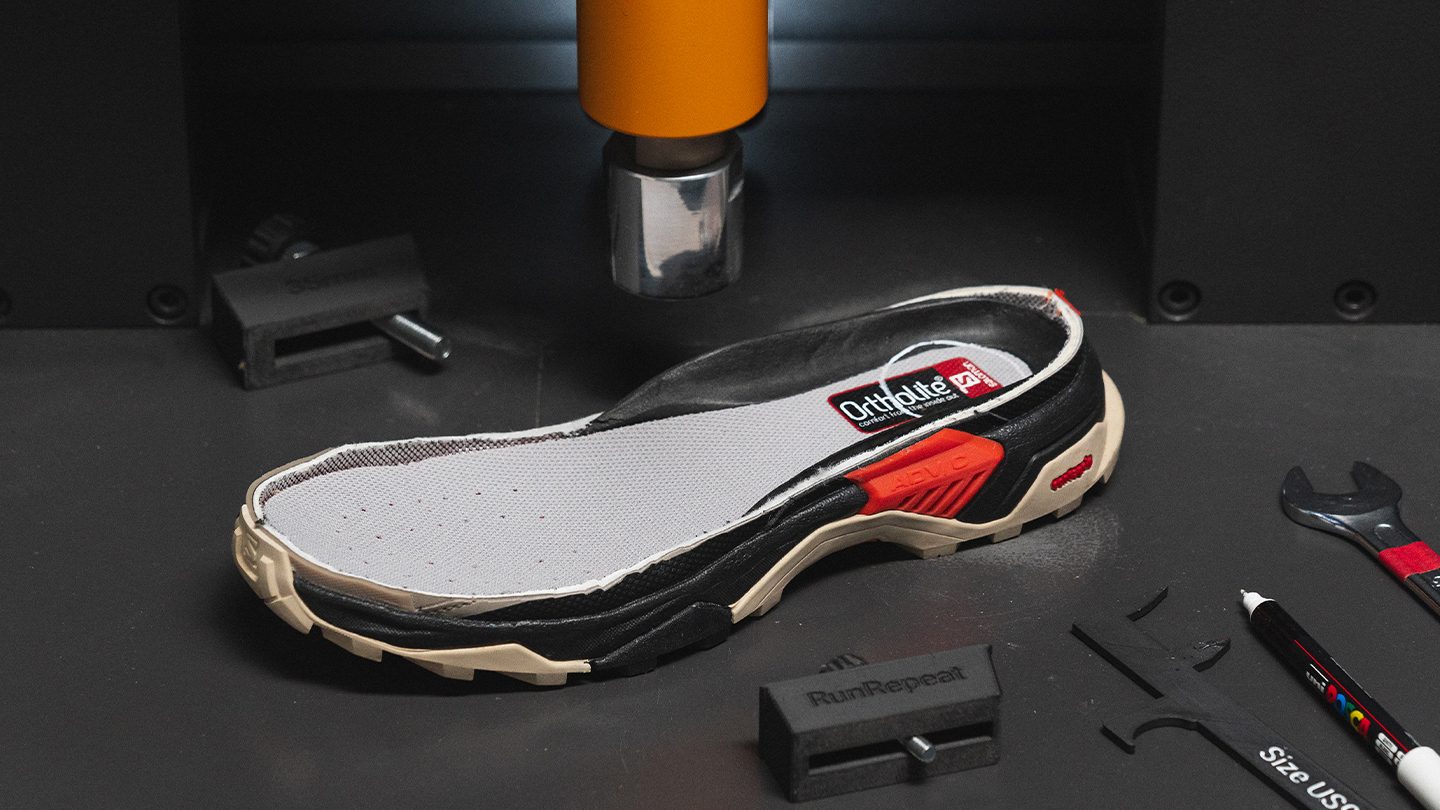
We buy shoes ourselves. We earn commissions when you buy through us, at no extra cost. Why trust us
Instantaneous comfort in hiking shoes is perceived thanks to the midsole softness. The softer it is, the more comfortable the shoes. However, in the long run hike, it’s the shock absorption that actually matters more. It is what keeps our legs fresh for longer. There are, of course, cases when this is not a priority and when other features take the spotlight. We go down this rabbit hole further below.
How we test Hiking shoes with the shock absorption
Our team working at the RunRepeat lab keeps the testing process completely transparent and objective. Here’s how:
- We buy all the hiking shoes with our own money. No deals with the brands, no sponsored posts, no marketing teams telling us what we can (not) write.
- We test the shoes on hikes to experience them and understand their pros and cons personally.
- We subject all the hiking shoes to the same tests under the same conditions. For the shock absorption test specifically, we honour the ASTM F1976 methodology: A mass weighing 8.5 kg is dropped from a height of 50 mm onto the heel. The total energy input here is 5J. We do 30 repetitions with a 2-second break between each. The first 25 repetitions simulate a natural break-in of the hiking shoe, while the last 5 are used for our lab data (we calculate the average).
- We publish all the test results on our website and allow visitors to compare all the lab test results within the same sports category.
In this guide, we highlight hand-picked shoes that outperformed the rest.
Best hiking shoes with high shock absorption overall
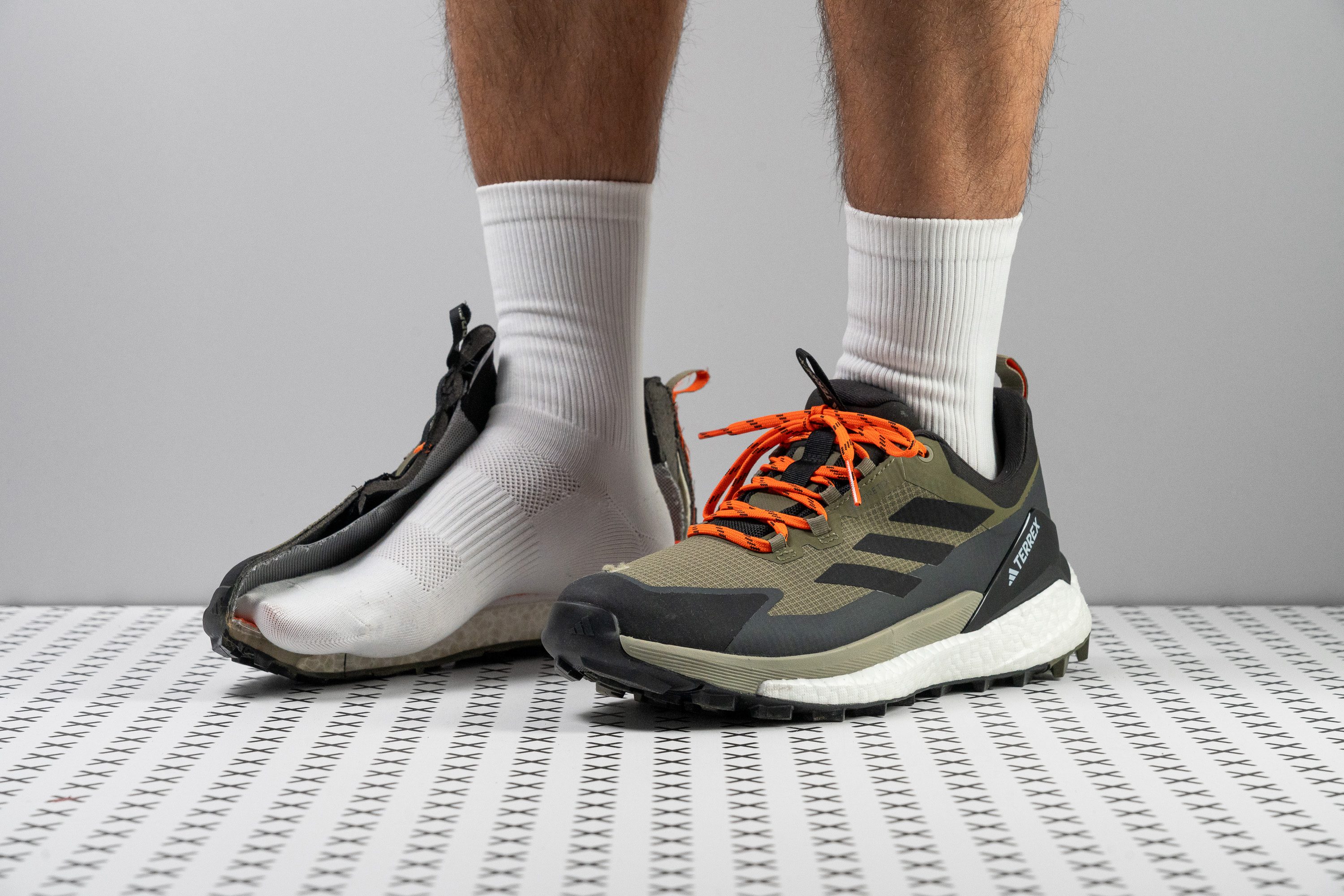



















































What makes it the best?
The Adidas Terrex Free Hiker 2.0 Low GTX is a joy to wear with its impact-dampening and steady ride. Lab results show its exceptional combination of height and softness, making it our best high shock absorption hiking shoe. Meanwhile, the Continental Rubber enhances control through its reliable traction.
We felt isolated from the ground, having a thick 37.2/24.6 mm buffer between our feet and the surface. For context, the average is only at 32.8/22.0 mm. Besides the additional foam, the cushion itself can reduce the forces of landing better than average. In our shock absorption test, we confirmed this observation with a high 126 SA score, 21.2% above average.
Despite its cloudlike sensation, we felt sure-footed and secure inside the base. Our calliper shows the heel is massive at 93.1 mm, giving us more room to find our footing. The midsole is also resistant to twisting in our manual assessment, so we rated it a solid 4/5 torsional rigidity score.
The Continental Rubber delivers exceptional grip, from hard-packed ground to moss-covered descents. In the heel, we measured a very aggressive depth of 6.7 mm, while the midfoot and forefoot lugs are a more modest 3.6 mm. These two types give us more versatility across different terrains.
However, we felt like dragging its heavy 15.7 oz (445g) weight around. We recommend speed hikers seeking agility to try a lighter pair.
Pros
- Well-cushioned and responsive
- A tonne of impact protection
- Rockered sole makes the ride smoother
- Barely gets firmer in low temperatures
- Excellent support and side-to-side stability
- Top-notch waterproofing
- Highly durable (especially the outsole)
- Ideal grip for technical terrain
- Sustainable materials (20%)
Cons
- Much heavier than average
- TPU heel clips may cause rubbing
Best hiking shoes with high shock absorption for summer
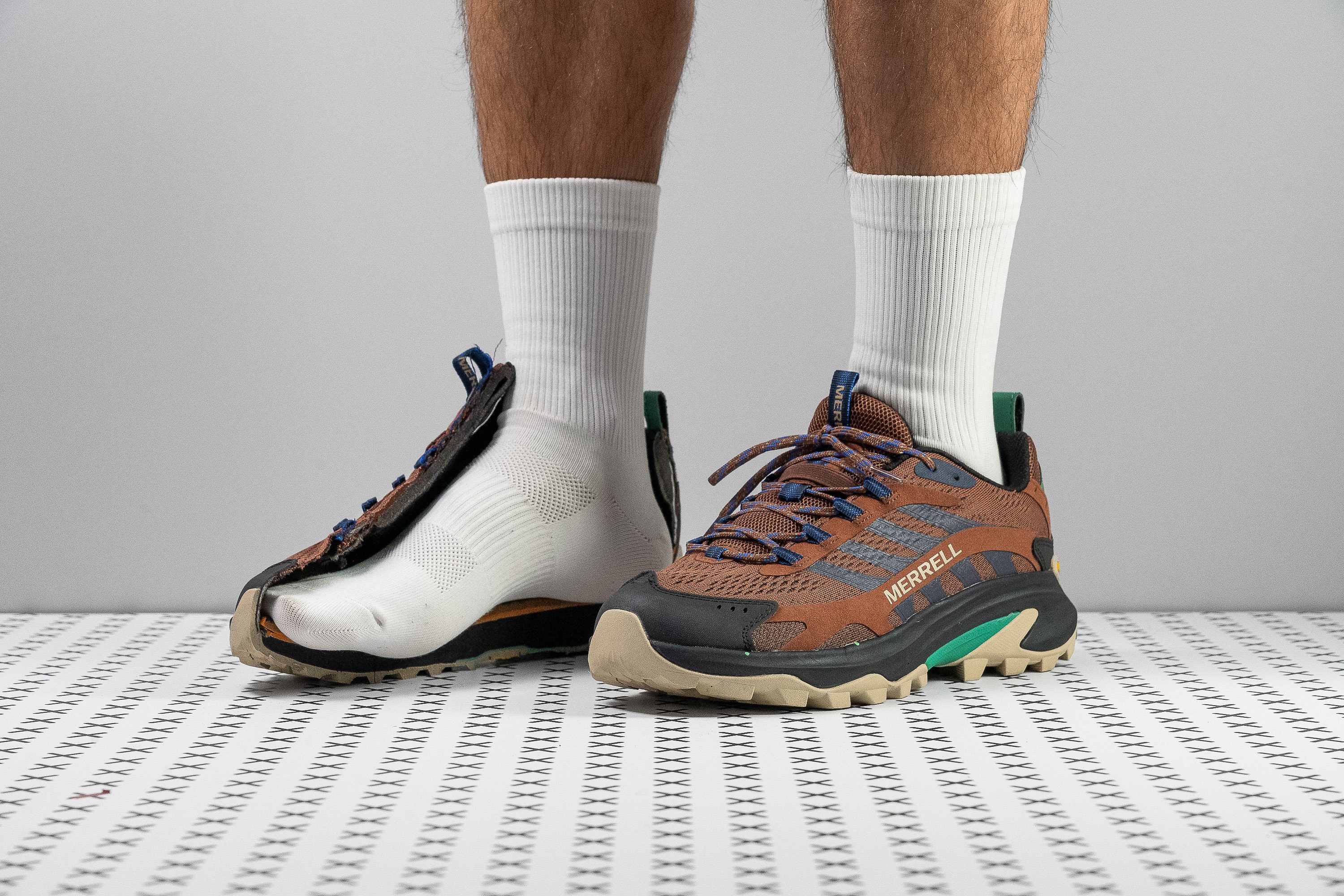























































What makes it the best?
The Merrell Moab Speed 2 has a refreshing aura that keeps us cool and calm on our hikes. From its superior breathability, which we observed in the lab, to its stacked and fatigue-reducing cushioning in a lightweight package, Moab Speed 2 is all about effortless comfort. Among high shock absorption hiking shoes, it takes the crown as the best for summer.
The upper is made of a breathable mesh that allows fresh air in and expels our body heat out. We observed a steady flow of vapour in our smoke test, so we awarded it an impressive 4/5 ventilation score. For context, hiking shoes we’ve tested only average 2.4, making the Moab Speed 2 an exceptional pick for hot weather.
Moab Speed 2 packs tonnes of plush cushioning in its midsole, verified by our calliper reading of 38.8/23.8 mm. Moreover, we recorded a high shock absorption score of 125 SA, meaning it’s able to reduce the forces of each landing on our muscles by 20.2% compared to the average.
Despite its abundant cushioning, this shoe weighs only 11.6 oz (329g), 13.4% below average. Its lightness helps maintain our legs’ freshness and allows us to rack up more miles.
This shoe is so welcoming that it uses a semi-gusseted tongue, which unfortunately can allow small rocks to slip inside. We recommend tying the laces securely to reduce the chances of this happening.
Pros
- One of the lightest hiking shoes
- Plush and abundant cushioning
- Great support and stability
- Perfect grip for moderate terrain
- Excellent durability
- Breathable for summer
- Cosy step-in feel
- Two loops for easy on-off
Cons
- Frail inner lining
- Small debris gets inside
High shock absorption hiking shoes with the best stability
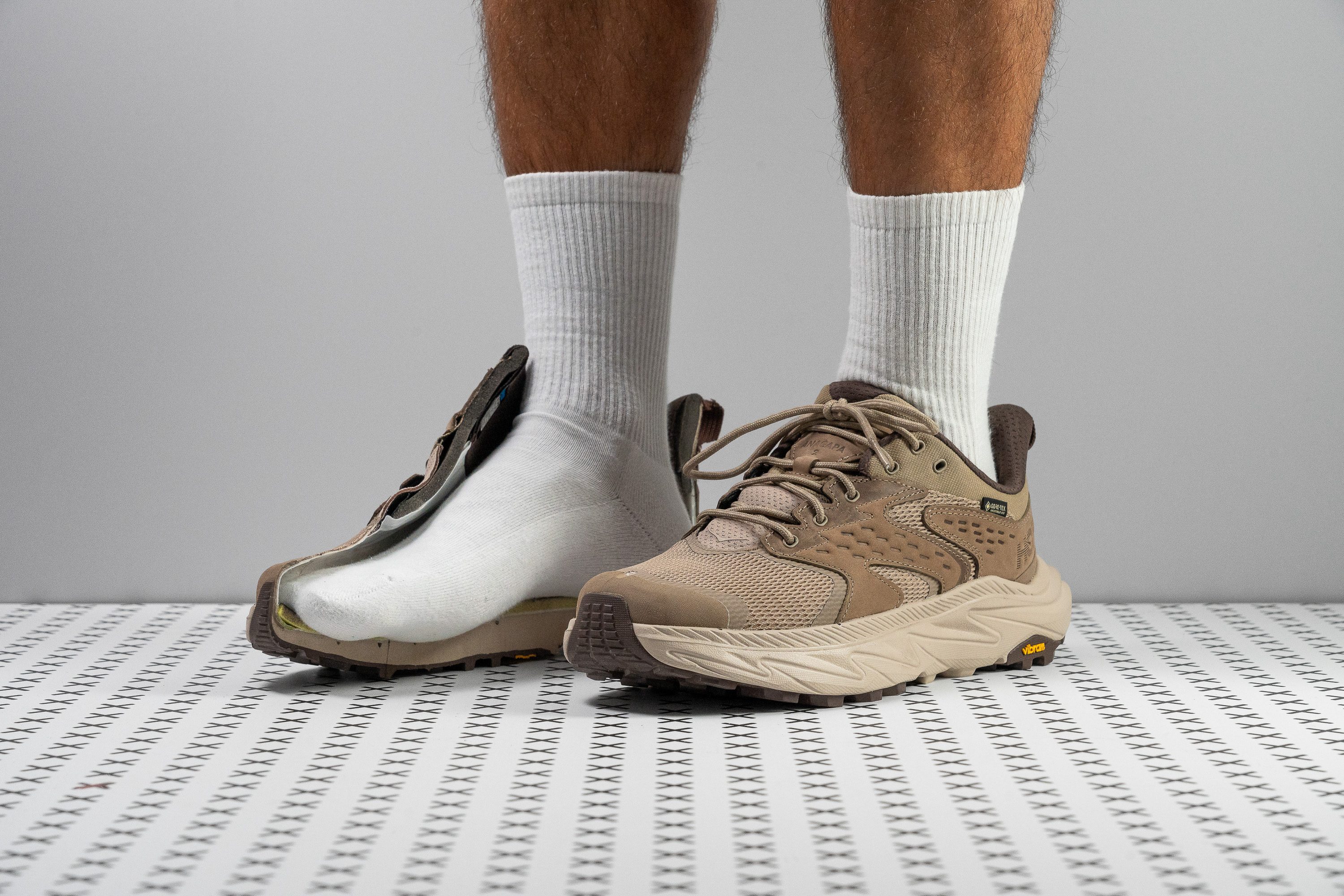

























































What makes it the best?
Pros
- Fantastic balanced cushioning for long hikes
- Excellent protection from impact, rocks, and trail debris
- Excepitional side-to-side containment and wide platform
- Perfect grip on various terrain
- Durable Vibram rubber
- Effective but lighter-feeling Gore-Tex waterproofing
- High-quality nubuck panels
- True to size
Cons
- Upper mesh is not very durable
- Loses midsole softness in cold
Best high shock absorption hiking shoes with a wide fit
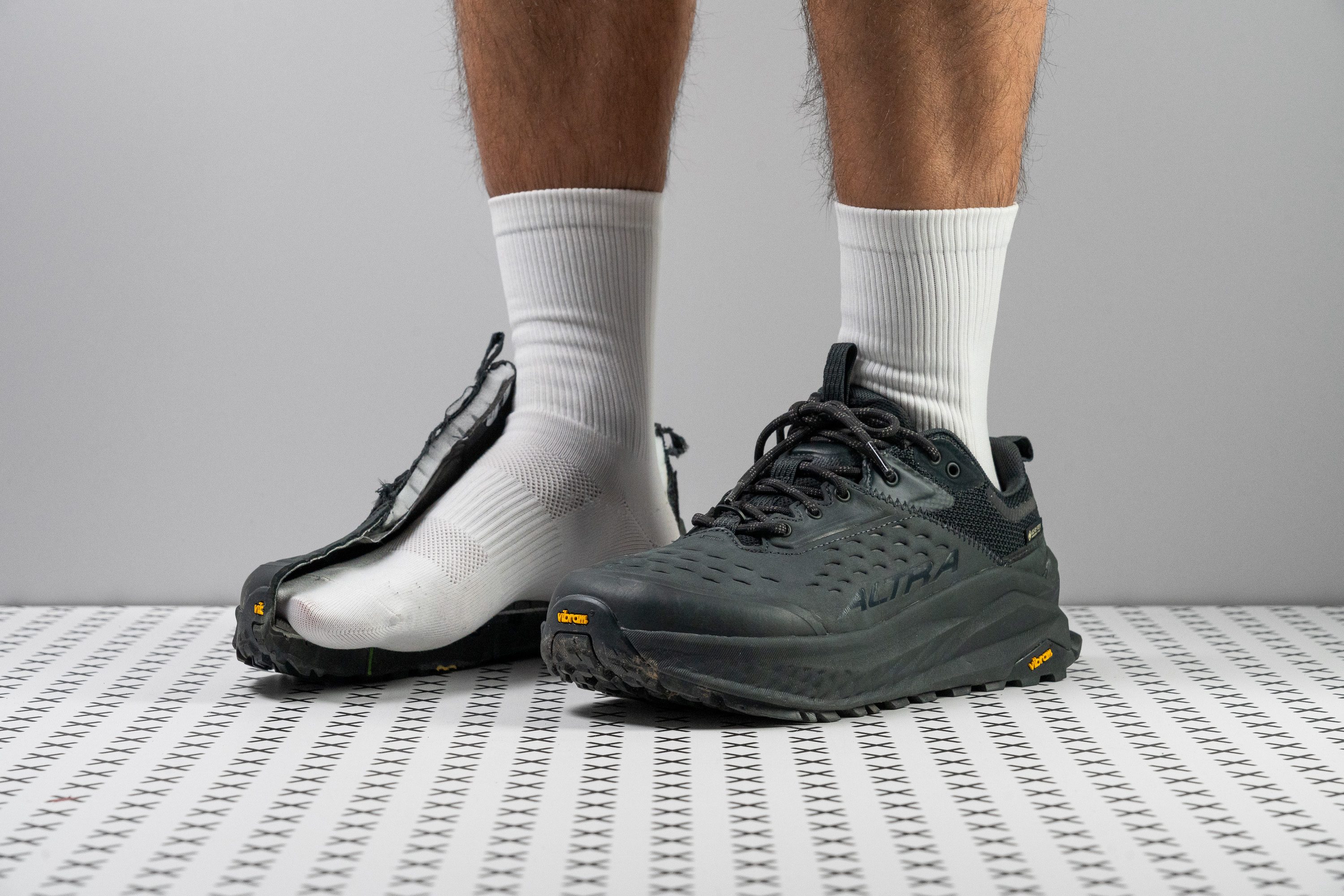
















































What makes it the best?
In our treks with the Altra Olympus 6 Hike Low GTX, we couldn’t help but notice that comfort takes centre stage. It’s packed with cushioning in the midsole and offers a roomy, accommodating fit, as confirmed by our lab tests, making it our best wide-fitted high shock absorption hiking shoe. With the reliable Vibram Megagrip rubber underfoot, we can confidently tackle a variety of trails without worrying about losing our footing.
We went straight to measuring the shoe’s width to confirm its promise of the Original FootShape Fit. Indeed, it delivers with a whopping 99.9 mm, freely accommodating those with extra broad or swollen feet.
The shoe feels chunky and luxuriously padded, and our calliper backs us up with a 31.0/29.5 mm stack, the forefoot being notably higher than the 22.0 mm average. While the heel has moderate height, it offers superior shock absorption of 118 SA, making it 13.5% more protective than average.
Underfoot, the Vibram Megagrip offers strong slip resistance. Testing for its traction, we recorded a strong 0.49 rating. It also features 3.2 mm versatile lugs to enhance our control during inclined segments.
In true Altra fashion, this shoe features a low 1.5 mm drop that may feel jarring for some hikers. We recommend those with lower-leg muscle strain, like in the ankles or Achilles, should find a pair with a steep offset.
Pros
- Excellent shock absorption
- Comfortably soft cushioning
- Ultra padded and cosy step-in feel
- Exceptionally wide fit and footshaped toebox
- Extra wide and stable platform
- Highly durable leather and outsole
- Excellent grip on smooth and wet rocks
- Solid waterproofing
Cons
- Not a true zero-drop (1.5 mm)
- Midsole gets notably firmer in cold
- Frail inner lining
Who benefits from high shock absorption the most?
Before thinking “I must find hiking shoes with the best shock absorption in the world”, we recommend understanding who these shoes are best for:
- High shock absorption is great for heavy hikers because their impact forces are higher (due to the weight) and they need cushioned hiking shoes that will be gentle toward their legs.
- Hikers covering longer distances. Impact forces build up over time (miles) and midsoles with very low shock absorption may cause your feet and legs to work significantly more and, therefore, end up with premature fatigue.
- Maybe you’re not heavy per se, but are hiking with a heavy backpack. This is when high shock absorption can help a lot, especially if you’re covering longer distances. Of course, heavy backpacks also ask for very stable hiking shoes (no wobbling, not too soft, and higher torsional rigidity). We’ve covered this in greater detail in the guide on backpacking shoes.
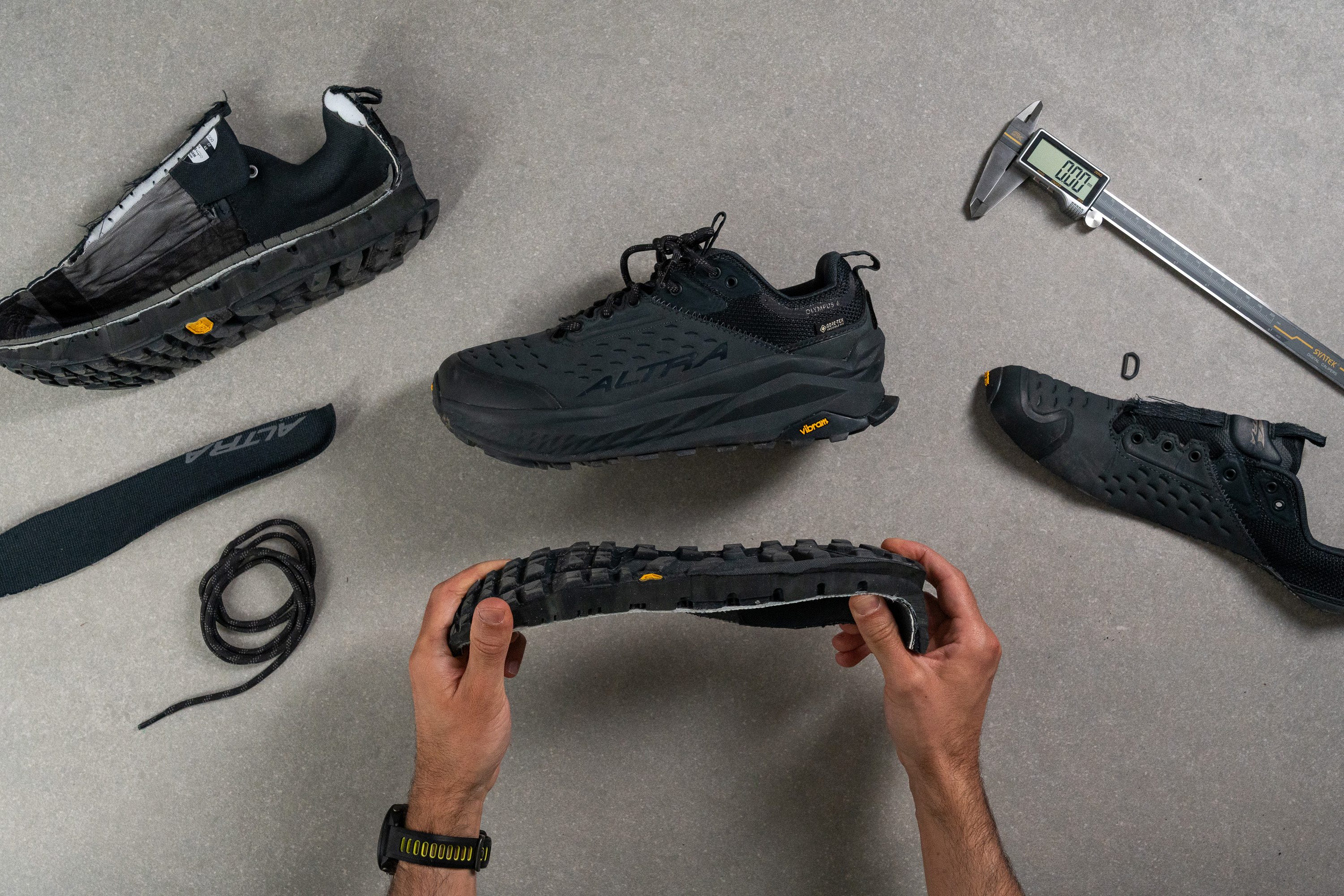
In our lab, we tear the shoes into pieces to be able to properly measure and test every little detail.
3 features of hiking shoes with high shock absorption
While some of these may be intuitive, it’s best to keep them in mind before deciding on a shoe with high shock absorption.
- It’s impossible to visually inspect a shoe and figure out how high its shock absorption is. It’s best to stick to the lab test results. Based on our lab data, anything higher than 115 SA is considered high shock absorption.
- These hiking shoes are, in general, softer than the average and higher at the heel (heel stack height measurement).
- On average, they weigh less than hiking shoes with medium or low shock absorption.
Cushioning trio: stack height, softness, and shock absorption
When we talk about cushioning and midsoles in hiking shoes, we have to know how stack height, softness, and shock absorption are connected and the effects their different values may have on hikers’ legs and performance.
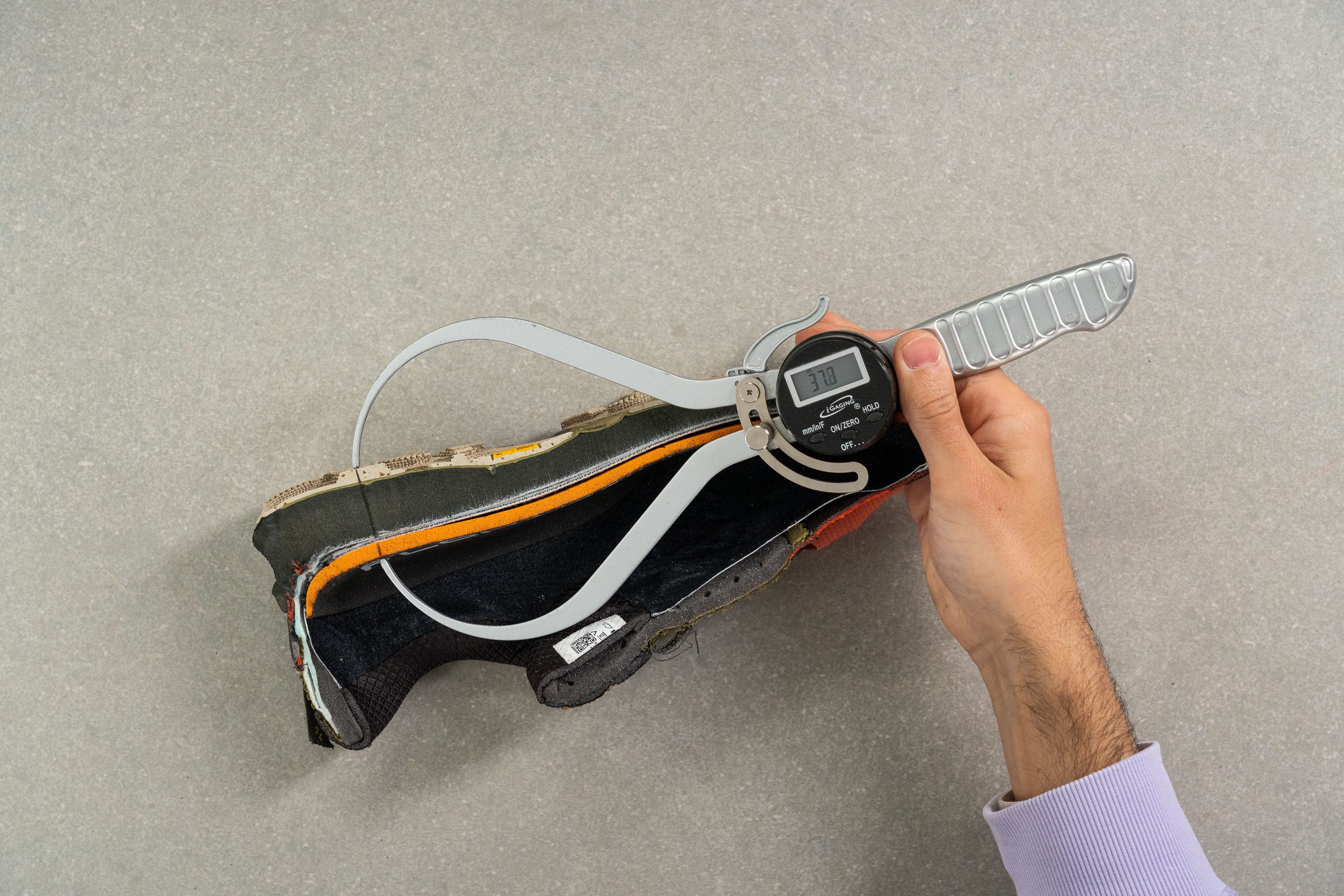
For a hiking shoe to have good shock absorption, it simply has to be higher off the ground. Barefoot and minimalist hiking shoes do not have midsoles thick enough to dampen the impact effectively.

High stack height is not a guarantee of good shock absorption, but low stack height can’t offer high shock-absorption values as we can see in the examples above
What also plays a big role here is how thick the outsole is and how deep the lugs are. They “take away” a lot from the overall stack height, which means there’s less space for the midsole, which is the part of the shoe doing the shock attenuation.
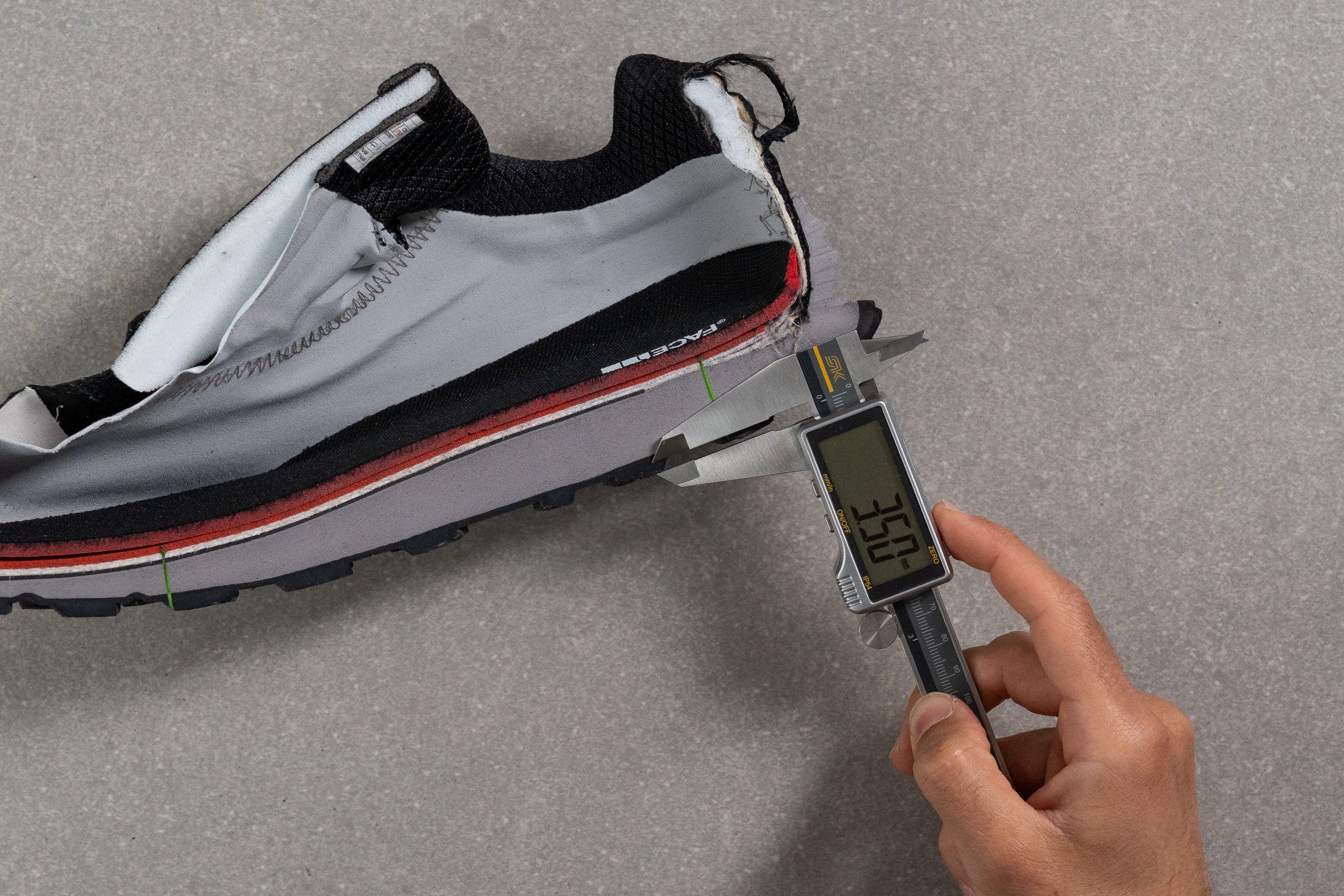
Hiking shoes with high shock absorption are softer, in general. Here’s an overview where we can see all 3 features:
|
Hiking shoes with… |
Average heel stack height |
Average midsole softness |
|
Low SA |
32.4 mm |
21 HA |
|
Moderate SA |
33.3 mm |
29 HA |
|
High SA |
36.5 mm |
23 HA |
Low shock absorption is lower than 100 SA, moderate between 100 and 115 SA, and high is 115+ SA.
Don’t forget the energy return in hiking shoes
Energy return is all the buzz in running shoes. In hiking, however, the needs are different, so other features are prioritised: grip, stability, and protection. However, we can’t talk about cushioning without mentioning energy return.
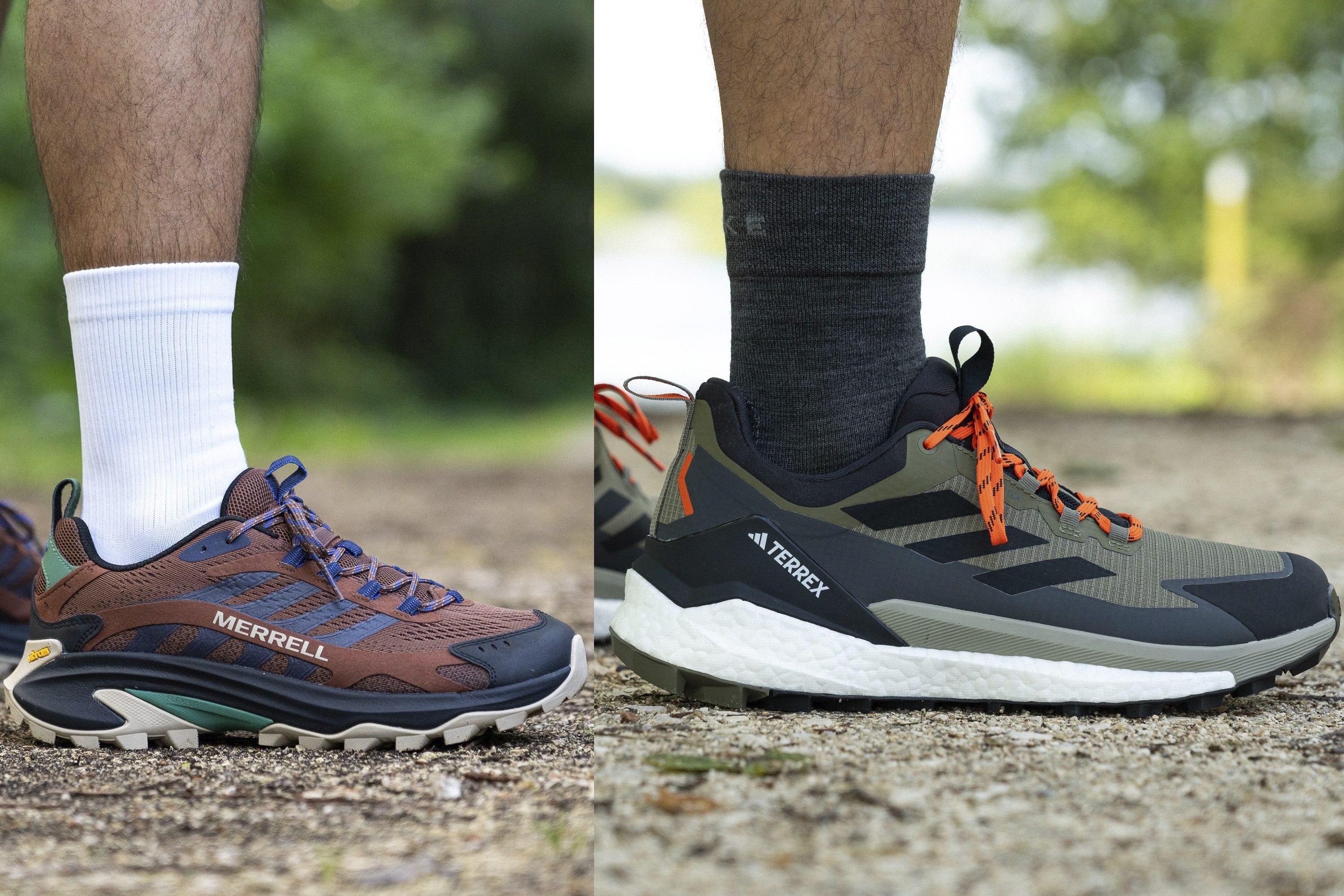
Energy return basically tells us how responsive and lively the ride is. Even if the midsole has great shock absorption, it can have very low energy return. This means that the foam isn’t good at bouncing back after being landed on, so your legs have to work extra. This is not an essential feature in hiking because, as mentioned, other features are prioritised. Still, if you’re hiking over shorter distances and want to go as fast as possible (usually called fast and light), you should take into account the energy return of your hiking shoes.
It’s not a rule, but in most cases, the lowest energy return is found in hiking shoes for technical terrain that are very stiff and protective.
Lower shock absorption: who is it for?
Based on the test results obtained in the lab, we have 3 groups of hiking shoes: low shock absorption (<100 SA), medium shock absorption (100-115 SA), and high shock absorption (>115 SA).

Low shock absorption is not bad, it’s actually good for hikers who need shoes for technical terrain. This comes with firmer (balanced or firm) platforms and high toebox durability, given that stability and protection are prioritised.
Are high-shock-absorption hiking shoes heavier?
On the contrary, they are lighter than hiking shoes with medium and low shock absorption. The reason lies in the fact that the shoes with lower shock absorption are made for more demanding terrain, and the protection and grip needed for that terrain come with more weight.
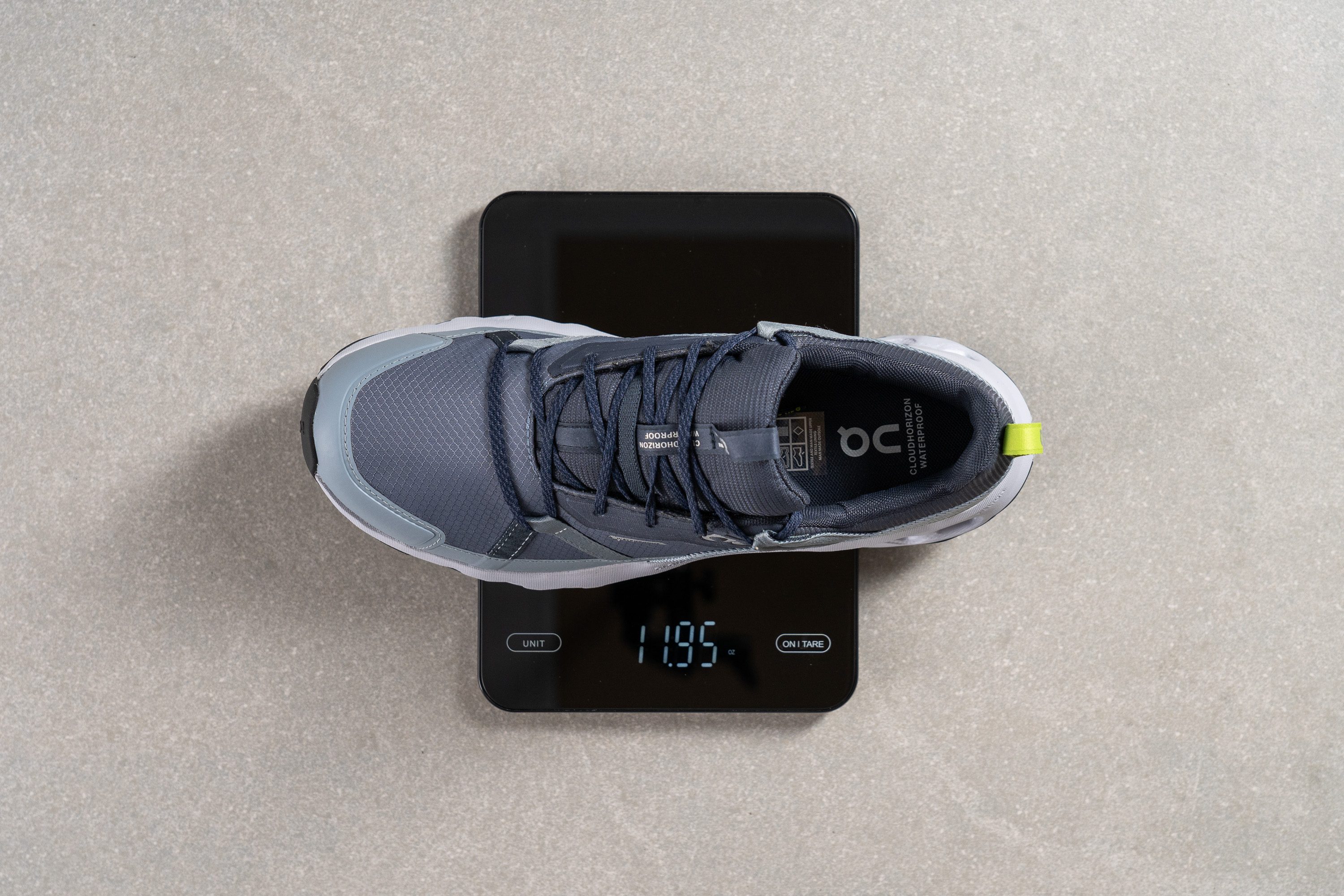
Each shoe that goes through the RunRepeat lab is weighed on the scale (in Men’s US 9)
|
Shock absorption |
Average weight |
|
Low |
14.4 oz | 407.0g |
|
Medium |
13.2 oz | 375.3g |
|
High |
12.9 oz | 365.3g |
Keep in mind that, at the moment of writing this guide, the average weight of all hiking shoes sits at 13.4 oz (380g).
Price of hiking shoes with high shock absorption
There’s no direct correlation between price and shock absorption in hiking shoes. This makes sense given how small piece of the puzzle shock absorption is and that there are many other technologies that are often prioritised.
MSRP is the manufacturer’s suggested retail price. It tells us how much the shoe cost when it was released, potential discounts excluded, of course.
Currently, the average price of hiking shoes with high shock absorption sits at £170.3. However, we always recommend finding a good deal, and our Deal page is a great place to start!

